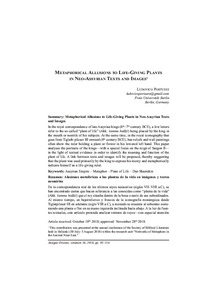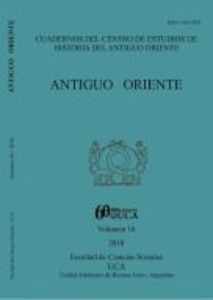Por favor, use este identificador para citar o enlazar este ítem:
https://repositorio.uca.edu.ar/handle/123456789/8714| Campo DC | Valor | Lengua/Idioma |
|---|---|---|
| dc.contributor.author | Portuese, Ludovico | es |
| dc.date.accessioned | 2019-09-10T19:43:24Z | - |
| dc.date.available | 2019-09-10T19:43:24Z | - |
| dc.date.issued | 2018 | - |
| dc.identifier.citation | Portuese, Ludovico. “Metaphorical allusions to life-giving plants in neo-assyrian texts and images” [en línea], Antiguo Oriente : Cuadernos del Centro de Estudios de Historia del Antiguo Oriente, 16 (2018). Disponible en: https://repositorio.uca.edu.ar/handle/123456789/8714 | es |
| dc.identifier.issn | 1667-9202 | - |
| dc.identifier.uri | https://repositorio.uca.edu.ar/handle/123456789/8714 | - |
| dc.description.abstract | Abstract: In the royal correspondence of late Assyrian kings (8th–7th century BCE), a few letters refer to the so-called “plant of life” (Akk. šammu balāṭi) being placed by the king in the mouth or nostrils of his subjects. At the same time, in the royal iconography that goes from Tiglath-pileser III onward (8th century BCE), bas-reliefs and wall paintings often show the ruler holding a plant or flower in his lowered left hand. This paper analyses the portraits of the kings—with a special focus on the reign of Sargon II— in the light of textual evidence in order to identify the meaning and function of the plant of life. A link between texts and images will be proposed, thereby suggesting that the plant was used primarily by the king to express his mercy and metaphorically indicate himself as a life-giving ruler. | es |
| dc.description.abstract | Resumen: En la correspondencia real de los últimos reyes neoasirios (siglos VII–VIII a.C), se han encontrado cartas que hacen referencia a las conocidas como “planta de la vida” (Akk. šammu balāṭi) que el rey situaba dentro de la boca o nariz de sus subordinados. Al mismo tiempo, en bajorrelieves y frescos de la iconografía monárquica desde Tiglatpileser III en adelante (siglo VIII a.C), a menudo se muestra al soberano sosteniendo una planta o flor en su mano izquierda inclinada hacia abajo. A la luz de fuentes textuales, este artículo pretende analizar retratos de reyes—con especial atención | es |
| dc.format | application/pdf | es |
| dc.language.iso | eng | es |
| dc.publisher | Universidad Católica Argentina. Facultad de Ciencias Sociales. Departamento de Historia. Centro de Estudios de Historia del Antiguo Oriente | es |
| dc.rights | Acceso Abierto : 1 año de embargo | * |
| dc.rights.uri | http://creativecommons.org/licenses/by-nc-sa/4.0/ | * |
| dc.source | Antiguo Oriente : Cuadernos del Centro de Estudios de Historia del Antiguo Oriente, 16 (2018) | es |
| dc.subject | ARTE ANTIGUO | - |
| dc.subject | ICONOGRAFIA | - |
| dc.subject | PINTURA | - |
| dc.subject | ASIRIA | - |
| dc.subject | RETRATOS | - |
| dc.title | Metaphorical allusions to life-giving plants in neo-assyrian texts and images | es |
| dc.title | Alusiones metafóricas a las plantas de la vida en imágenes y textos neoasirios | es |
| dc.type | Artículo | es |
| uca.disciplina | HISTORIA | es |
| uca.issnrd | 1 | es |
| uca.affiliation | Fil: Portuese, Ludovico. Freie Universität Berlín; Alemania | es |
| uca.version | publishedVersion | es |
| item.languageiso639-1 | en | - |
| item.grantfulltext | open | - |
| item.fulltext | With Fulltext | - |
| Aparece en las colecciones: | AO - 2018 vol. 16 | |
Ficheros en este ítem:
| Fichero | Descripción | Tamaño | Formato | |
|---|---|---|---|---|
| metaphorical-allusions-lifegiving-plants.pdf | 1,61 MB | Adobe PDF |  Visualizar/Abrir | |
| Antiguo Oriente 16 2018.jpg | 2,99 kB | JPEG |  Visualizar/Abrir |
Visualizaciones de página(s)
368
comprobado en 19-dic-2025
Descarga(s)
845
comprobado en 19-dic-2025
Google ScholarTM
Ver en Google Scholar
Este ítem está sujeto a una Licencia Creative Commons

